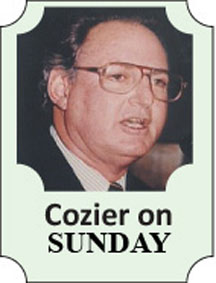DESCRIBED by the West Indies Cricket Board as “the legendary Pakistan off-spinner”, Saqlain Mushtaq has been added to the team’s coaching staff for the couple of Twenty20s and the solitary One-Day International against Ireland in Jamaica at the end of the week. Presumably, he will have for a more extended period after that.
Saqlain, who conducted a clinic for selected spinners last year in Barbados, “has joined the team management unit to fortify this area that has become critical in the side’s armoury,” the WICB stated. Those bowlers under him in Barbados, especially Shane Shillingford, spoke glowingly of Saqlain’s effect. Shillingford’s subsequent suspension for an action that went beyond the allowed 15 degree flex in the elbow was disheartening; surely Saqlain could not be held responsible.
The Pakistani, 208 wickets in 49 Tests between 1995 and 2003 and credited as the originator of the ‘doosra’, performed so creditability that he has now been retained on a more formal basis; his expertise is to be welcomed.
 Even so, spin bowling is not the area presently requiring most attention at all levels of West Indies cricket. Nor, since the eras of Sonny Ramadhin, Alf Valentine and Lance Gibbs, has it been “critical in the team’s armoury”.
Even so, spin bowling is not the area presently requiring most attention at all levels of West Indies cricket. Nor, since the eras of Sonny Ramadhin, Alf Valentine and Lance Gibbs, has it been “critical in the team’s armoury”.
The times of West Indies’ supremacy have been mainly based on a combination of irresistible fast bowling and high quality batting – in the 1960s, the pace of Hall, Griffith and Sobers supported by Gibbs’ off-spin, all in tandem with the consistent runs from Hunte, Kanhai, Sobers, Butcher, Nurse; Roberts, Holding and their lethal accomplices made the most of the unparaleld batting of Greenidge, Haynes, Richards, Lloyd, Richards, Dujon et al in the 1980s.
There are a host of obvious reasons for the West Indies’ dramatic deterioration over the past two decades – sub-standard pitches, unreliable umpiring, constant squabbling between the WICB and the players’ association among them. Players attitudes have also changed with the advent of lucrative Twenty20 franchise leagues, especially the Indian Premier League (IPL).
They are all manifested in the decline of batting standards and the dearth of the successors of Hall, Roberts, Holding, Ambrose, Walsh and the other exceptional fast men.
The evidence on the batting is most alarming.
In the 10 innings in five Tests on the most recent tours of India and New Zealand, there were six totals under 200, including 103 against New Zealand.
In the regional Nagico Super50 tournament in Trinidad and Tobago over the past couple of weeks, the returns were even more shocking.
The Leewards Islands, once the home team of the great Viv Richards and Richie Richardson, were rolled for 80 (‘recovering’ from 39 for nine) by the Combined Campuses and Colleges (CCC), 103 by Barbados and 140 by Trinidad and Tobago.
The CCC, introduced mainly as a development team by the WICB in 2007, crashed for 98 against Trinidad and Tobago. Jamaica, powerhouses at regional level for some time, collaped to 49 all-out in the semi-final against Trinidad and Tobago. Even without the injured Chris Gayle and Marlon Samuels, it was an embarrassment; there was no need for the floodlights.
One factor was the effect of overuse of the dry square at the Queen’s Park Oval (10 matches in 14 days on three pitches); the early totals reflected the excellence of the pitches before they became drier. Yet not just spin but even minimal swing posed problems for batsmen lacking the basic techniques to cope.
Of even greater concern are the similar batting failures of the Under-19 team.
In seven 50-overs matches against Bangladesh at home last October and one in Bangladesh in December, the young West Indians managed just one total over 200; among the others were 88, 101 and 118. The pattern continued in their opening match of the Under-19 World Cup in Dubai – 104 all out that led to a 94-runs loss to South Africa.
Nor are such statistics a recent occurrence. For years, the regional four-day tournament has been littered with primary school totals.
The situation cries out for urgent concentration on batting in every territory. A specialist batting coach is even more essential to assist Stuart Williams who was appointed as an assistant coach last year.
There are any number of “legendary” West Indians capable of filling the post.
Gordon Greenidge, as technically correct as any batsman during the 16 years and 108 Tests he opened with Desmond Haynes, immediately springs to mind.
He has the credentials of a successful coach who raised standards in Bangladesh only to be fired after warning them that they were not ready for their promotion to Test cricket on the strength of their one-day record at associate level and a questionable victory over Pakistan in the 1999 World Cup.
Ottis Gibson was the bowling coach to England before he became the West Indies’ head coach in 2010. He must be excited by the young talent now emerging and another who has returned to the game after a break of two years.
The towering Jason Holder has already made his mark in the shorter formats. Ronsford Beaton, the slim, decidedly slippery Guyanese, and Miguel Cummins have caught the eye at regional level. Holder is 22, Beaton 21, Cummins 23. Gibson needs the support of a legendary expert to bring them on, someone like Curtly Ambrose who is doing the job at the CCC.
The most exciting advance in the Nagico Super50 was the return to the Jamaica team of Jerome Taylor.
He had 82 wickets in 29 Tests between 2003 and 2009, his 9-4-11-5 demolition of England for 51 at Sabina Park emphasized his class. By the end of the year, injury put him out of the first Test against Australia in Brisbane and, for reasons not entirely clear he went out of cricket when he should have been at the peak of his powers.
He was understandably a little rusty in the first match; by the next two, he was the old Taylor, smooth as Jamaican Tia Maria in his approach, passing tentative edges with his lively pace and movement. Even at 29, he looks fit and keen.
Saqlain is all well and good but the WICB has got its priorities wrong.






